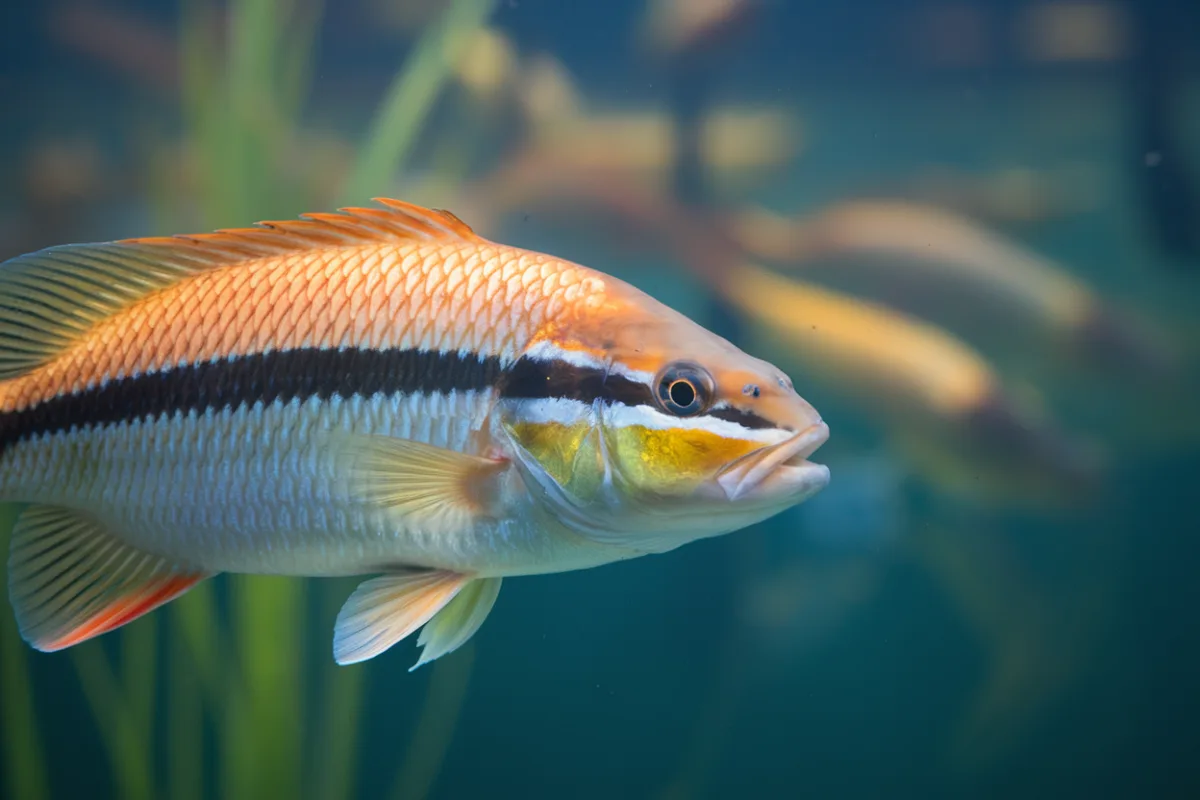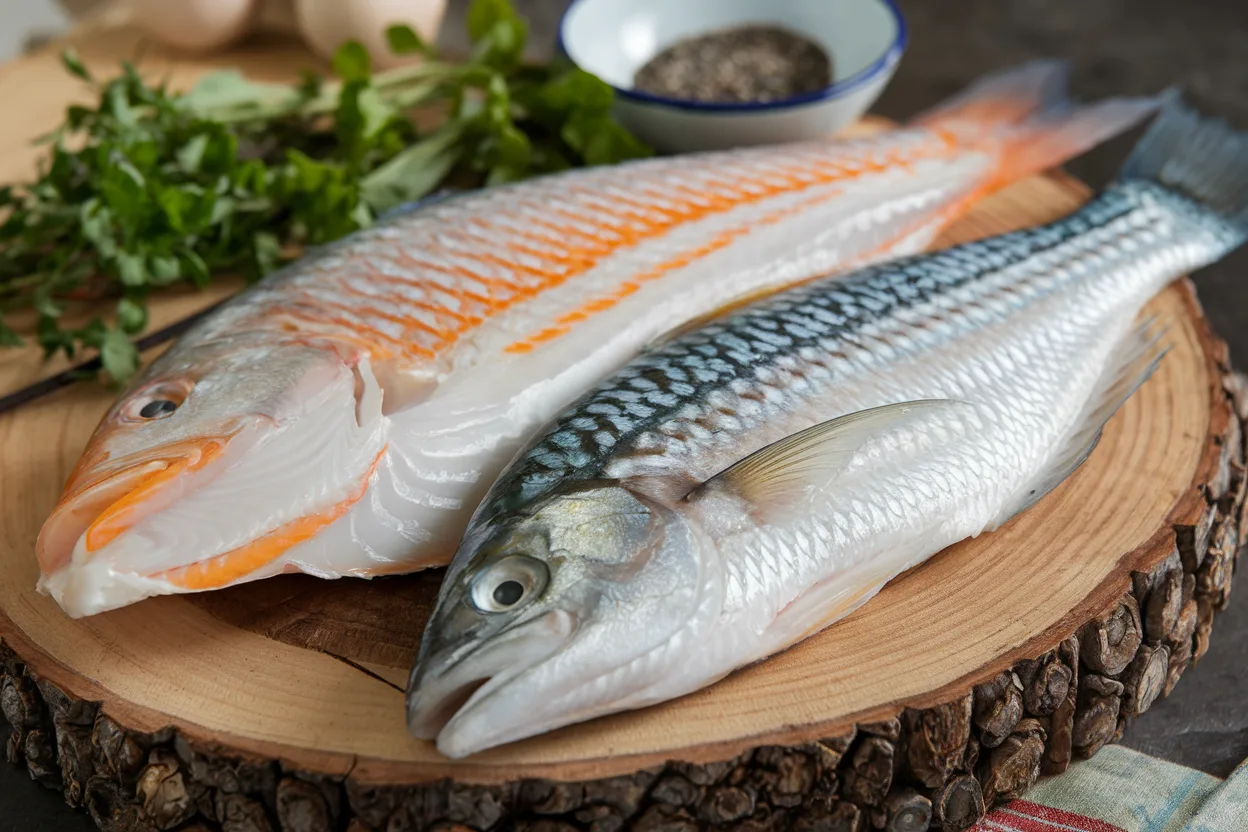Ever found yourself standing in the seafood aisle, debating between barramundi and tilapia? You’re not alone.
These two fish are popular choices for many home cooks. But how do they stack up in terms of taste?
In this article, we’ll dive into the flavor profiles of both barramundi and tilapia. We’ll explore their unique characteristics and how they compare to each other.
Whether you’re a busy parent looking for a quick, nutritious meal or a beginner cook eager to expand your culinary skills, this guide is for you.
So, let’s embark on this tasty journey and find out: does barramundi taste like tilapia?
Barramundi and Tilapia: An Overview
Before we dive into the taste comparison, let’s get to know our contenders a bit better.
Barramundi and tilapia are both freshwater fish. They’re loved by many for their unique flavors and versatility in the kitchen.
Here’s a quick rundown of their key characteristics:
- Barramundi: Known for its buttery taste and firmer texture. Often compared to snapper and grouper in terms of flavor. Sometimes referred to as Asian sea bass.
- Tilapia: Praised for its mild flavor and versatility in recipes. A good option for those who prefer a less “fishy” taste.
What is Barramundi?
BarramuExploring the Culinary Delights of Barramundindi is a type of seabass native to Australia and the Indo-Pacific. It’s a prized catch among anglers and a favorite among chefs for its premium taste
The fish has a firm, white flesh and a rich, buttery flavor. It’s often compared to snapper and grouper, but with a unique taste all its own.
Barramundi is also considered a sustainable seafood choice, making it a great option for environmentally conscious consumers.
What is Tilapia?
Tilapia, on the other hand, is a type of cichlid fish that’s native to Africa. It’s one of the most popular farmed fish worldwide due to its fast growth and adaptability to various farming conditions.

Tilapia has a mild, almost sweet flavor and a tender texture. It’s a versatile fish that can be used in a wide range of dishes, from tacos to stir-fries.
It’s also a staple in many households due to its affordability and availability.
Nutritional Profiles: Barramundi vs. Tilapia
When it comes to nutrition, both barramundi and tilapia pack a punch. They’re excellent sources of protein and essential nutrients, making them a healthy choice for any meal.
Here’s a quick comparison of their nutritional profiles per 100g serving:
- Barramundi: 92 calories, 20g protein, 1.3g fat, 0g carbs, 600mg omega-3 fatty acids
- Tilapia: 96 calories, 20g protein, 1.7g fat, 0g carbs, 200mg omega-3 fatty acids
Barramundi stands out for its higher omega-3 fatty acid content. These healthy fats are known for their heart health benefits and anti-inflammatory properties.
On the other hand, tilapia, while lower in omega-3s, is still a lean source of protein. It’s also slightly higher in fat content, but still falls under the category of low-fat foods.
In terms of vitamins and minerals, both fish are rich in Vitamin D, B-vitamins, and essential minerals like selenium and potassium. So, no matter which one you choose, you’re in for a nutritious treat!
Taste Test: Comparing Barramundi and Tilapia
Now, let’s dive into the taste comparison between barramundi and tilapia. After all, taste is a major factor when choosing a fish for your meal.
Both fish have their unique flavor profiles, and your preference may depend on your palate. Some people prefer a mild, versatile fish like tilapia, while others might be drawn to the richer, buttery taste of barramundi.
It’s also worth noting that the taste of these fish can be influenced by their diet and environment. For instance, tilapia’s taste can vary depending on the quality of the water it was farmed in.
Barramundi’s Flavor Profile
Barramundi is often praised for its unique flavor. It’s described as having a sweet, buttery taste with a hint of almonds.
The texture of barramundi is another highlight. It’s firm yet delicate, making it a pleasure to eat. Plus, its skin crisps up beautifully when seared, adding an extra layer of texture to your dish.
Barramundi’s rich flavor often draws comparisons to snapper and grouper. It’s a good choice for those looking to try a new fish with a unique flavor profile.
Tilapia’s Flavor Profile
On the other hand, tilapia is known for its mild flavor. It’s a versatile fish that can take on the flavors of the ingredients it’s cooked with.
Tilapia’s texture is less firm than barramundi’s, with a flaky consistency that many people enjoy. Its fillets are often thinner and cook more quickly, making it a great choice for quick weeknight dinners.
For those who prefer a less “fishy” taste, tilapia is a good option. It’s a staple in many households due to its affordability and mild taste.
Cooking Techniques to Enhance Fish Flavors
Cooking methods can greatly affect the taste and texture of both barramundi and tilapia. The right technique can enhance their natural flavors and make your meal even more enjoyable.
Here are some popular ways to prepare these fish:
- Grilling: This method imparts a smoky flavor and creates a nice crust on the fish.
- Baking: A healthier option that keeps the fish moist and tender.
- Pan-frying: Quick and easy, this method gives the fish a crispy exterior and a flaky interior.
Best Ways to Cook Barramundi
Barramundi is a versatile fish that can be cooked in a variety of ways. However, its firm texture and rich flavor make it particularly well-suited to certain methods.
Pan-frying is a popular choice for barramundi. The skin crisps up nicely, adding a delightful crunch to your dish. Grilling is another great option, especially for thicker fillets. The high heat seals in the juices and enhances the fish’s natural flavors.
Best Ways to Cook Tilapia
Tilapia, with its mild flavor and flaky texture, is also adaptable to many cooking methods. Its thin fillets cook quickly, making it a great choice for busy weeknight meals.
Grilling tilapia gives it a smoky flavor that can be a nice contrast to its mild taste. Baking is another good option, especially when you want to infuse the fish with the flavors of your chosen seasonings and marinades. Pan-frying, too, works well with tilapia, creating a crispy exterior that’s sure to please.
Health Benefits: Why Include Fish in Your Diet?
Fish, including barramundi and tilapia, are excellent sources of protein and essential nutrients. They’re a healthy choice for any meal, and they offer several benefits that make them a great addition to your diet.
Here are some reasons why you should consider including fish in your diet:
- High in Protein: Fish is a great source of high-quality protein, which is essential for muscle growth and repair.
- Rich in Omega-3 Fatty Acids: These healthy fats are good for your heart and brain. Barramundi, in particular, has a higher omega-3 content compared to tilapia.
- Low in Mercury: Both barramundi and tilapia are low in mercury, making them safe choices for regular consumption.
- Packed with Vitamins and Minerals: Fish is rich in vitamins like B12 and D, and minerals like iodine and selenium.
Including fish in your diet can contribute to a balanced and nutritious eating plan. Whether you’re a busy parent looking for healthy meal options or a beginner cook wanting to expand your culinary skills, fish is a versatile and nutritious choice.
Sustainability: Farming Practices of Barramundi and Tilapia
When it comes to choosing fish, sustainability is a key factor to consider. It’s not just about the taste, but also about how the fish are raised and the impact on the environment.
Barramundi is often praised for its sustainable farming practices. Many barramundi farms focus on environmental sustainability, ensuring that the fish are raised in conditions that mimic their natural habitat. This not only results in a better-tasting fish but also helps to preserve the natural ecosystem.
On the other hand, tilapia is known for its ability to be farmed in a variety of conditions. This makes it a highly accessible fish globally. However, the farming practices can vary greatly, and in some cases, they may not be as environmentally friendly. It’s important to check for sustainability certifications when purchasing tilapia.
In conclusion, both barramundi and tilapia have their pros and cons when it comes to sustainability. As consumers, it’s our responsibility to make informed choices that not only satisfy our taste buds but also contribute to the well-being of our planet.
Simple and Delicious Fish Recipes for Busy Parents and Beginner Cooks
Now that we’ve explored the taste profiles and nutritional benefits of both barramundi and tilapia, let’s dive into some simple and delicious recipes. These are perfect for busy parents and beginner cooks looking to incorporate more fish into their meals.
Quick Barramundi Dishes
Barramundi’s unique flavor profile makes it a star in many dishes. One simple way to prepare it is by pan-searing. Season the fish with salt, pepper, and a squeeze of lemon, then sear it in a hot pan with a bit of olive oil. The result is a crispy skin and tender, flavorful flesh.
Another quick and easy barramundi dish is a simple fish curry. Cook the barramundi in a sauce of tomatoes, onions, garlic, and a blend of spices like turmeric, cumin, and coriander. Serve it over rice for a hearty and flavorful meal.
Easy Tilapia Meals
Tilapia’s mild flavor makes it a versatile choice for a variety of dishes. For a quick and healthy meal, try baking tilapia fillets with a topping of breadcrumbs, parmesan, and herbs. This gives the fish a deliciously crispy crust.
Fish tacos are another easy and tasty way to enjoy tilapia. Grill or pan-fry the tilapia, then serve it in tortillas with a fresh slaw and a tangy yogurt sauce. It’s a fun and flavorful meal that’s sure to be a hit with the whole family.
Selecting and Storing Your Fish: Tips for Freshness
Choosing fresh fish is crucial for the best taste and texture. When selecting barramundi or tilapia, look for bright, clear eyes and firm, shiny flesh. The fish should smell fresh, not fishy or sour.
Here are some tips for storing your fish to maintain its freshness:
- Refrigerate fresh fish immediately and use it within 1-2 days.
- If you’re not planning to cook the fish right away, freeze it. Frozen fish can last up to six months.
- Keep the fish in its original packaging until you’re ready to cook it.
- If the fish is already cooked, store leftovers in an airtight container in the fridge and consume within 2-3 days.
Proper storage not only ensures the best taste but also prevents foodborne illnesses. So, remember these tips next time you bring home some fresh barramundi or tilapia.
Conclusion: Making the Right Choice for Your Palate and Lifestyle
So, does barramundi taste like tilapia? Not quite. While both are versatile and nutritious, they offer distinct flavors and textures. Barramundi’s buttery taste and firmer texture make it a gourmet choice, while tilapia’s mild flavor and affordability make it a household staple.
Choosing between barramundi and tilapia ultimately depends on your personal taste, budget, and cooking style. Whether you’re a busy parent looking for quick dinner solutions or a beginner cook eager to expand your culinary skills, both fish can be a delicious addition to your menu. Happy cooking!
